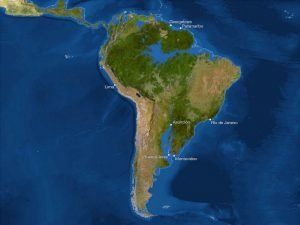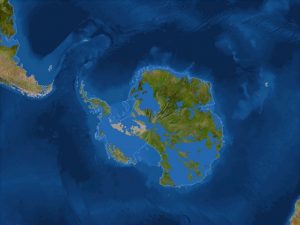If we continue to burn fossil fuels endlessly, the melting of ice in the poles and on the tops of the mountains will become an inevitable result of global warming, leading to a height of 216 feet.

Explore how the new world will look like.

These maps show the world in its current form, but there is only one difference: all the ice on the surface of the earth has melted and mixed with seawater.
Resulting in a 216-foot sea-level rise and the formation of new beaches for closed continents and seas.
There are more than five million cubic miles of ice on the ground, some scientists say that it will take more than 5,000 years for the ice to completely melt.
If we continue to emit carbon in our atmosphere, it is very likely that the planet will be completely dissipated from any ice, at a temperature of 80 Fahrenheit instead of 58 degrees now.
North Amarica
The entire Atlantic coast, as well as Florida and Gulf Coast, will disappear. In California, the San Francisco Hills will turn into an archipelago (islands), and the Central Valley will become a giant bay.
The Bay of California will expand northwards to the San Diego line of San Diego.

South america
The Amazon basin in the north and the Paraguayan basin in the south will be transformed into two inlets of the Atlantic Ocean, which will wipe out Argentina's capital Buenos Aires, the coasts of Uruguay and much of Paraguay.
Mountain stretches will extend along the Caribbean and in Central America.

Africa
Compared to other continents, Africa will lose little land, but the high temperature of the Earth could make a large part of it unfit for life.
In Egypt, Cairo and Alexandria will disappear because the Mediterranean Sea is flooded.

Europe
London? memory. Venice? Soaked in the Adriatic Sea.
Thousands of years from now, the Netherlands will have surrendered to the sea long ago in that nightmare scenario, as well as much of Denmark.
During this time, the Black Sea and the Caspian Sea will be swallowed up by the waters of the Mediterranean Sea.

Asia
An area of land with 600 million Chinese will be flooded, Bangladesh will be flooded with a population of 160 million and a large part of the Indian coast.
The Mekong delta will be flooded with mountains in Cambodia and surrounded by water as an island.

Australia
Mostly desert, will have new inland seas - but will lose much of the narrow coastline where most Australians now live.

ntarctica
Eastern Antarctica: Its ice cover is massive - contains four-fifths of ice on the surface of the earth - making it appear insoluble.
It has gone through previously warm periods without being hurt.
Recently, the ice appears to be less thick; because of global warming.
The warm atmosphere contains more water vapor, which turns ice in the eastern Antarctica.
However, this ice is unlikely to survive if we return to the climate of the Eocene Age.
Western Antarctica: Its ice cover was much smaller during warm old times. J
The bulk of them fell below sea level, making them weaker.
The warming of the ocean causes the melting of the floating ice sheet to melt.
Since 1992, the average ice loss has been estimated at 65 million tons per year.

the source
https://www.nationalgeographic.com/magazine/2013/09/rising-seas-ice-melt-new-shoreline-maps/
Good to bring more awareness to this. Fortunately sore is getting cheaper and cheaper and if we use it to power electric cars this will make part of the difference we need to turn things around.
Downvoting a post can decrease pending rewards and make it less visible. Common reasons:
Submit
I agree with you very much
Downvoting a post can decrease pending rewards and make it less visible. Common reasons:
Submit
That is a lot of great information! It opens me up to several questions. I wonder if we get a couple ideas mixed up. One main line of thinking is "hey we are emitting all this carbon, we are effecting the planet badly so we should stop or ice meltage will burry coasts underwater. So things like chem trails and weather modifications are justified to fix the problem
But in the past when humans had no industrialization there was so much carbon in the atmosphere that plants and animals were very large! This was good for the plants which breath carbon dioxide. The land masses were also much larger being above water in the past in many places long covered. This shows us that this worry we have and are blaming on our carbon use, has happened before without industry. This planet has gone through warming tropical weather supportive of vast expansive immense creatures and plant life. It has also gone into ice age which we have been melting out of for thousands of years.
Now if effort should be made to save lives if people on coasts, that's another matter but should we be trying to change nature to save human life. Or preserve nature and adjust our selves accordingly?
Downvoting a post can decrease pending rewards and make it less visible. Common reasons:
Submit
Good information and addition
Downvoting a post can decrease pending rewards and make it less visible. Common reasons:
Submit
This post was resteemed by @resteembot!
Good Luck!
Curious? Check out:
The @resteembot users are a small but growing community.
Check out the other resteemed posts in resteembot's feed.
Some of them are truly great.
Downvoting a post can decrease pending rewards and make it less visible. Common reasons:
Submit
This post was resteemed by @resteembot!
Good Luck!
Curious? Check out:
The @resteembot users are a small but growing community.
Check out the other resteemed posts in resteembot's feed.
Some of them are truly great.
Downvoting a post can decrease pending rewards and make it less visible. Common reasons:
Submit